Dwelling in an age of aeromodernism
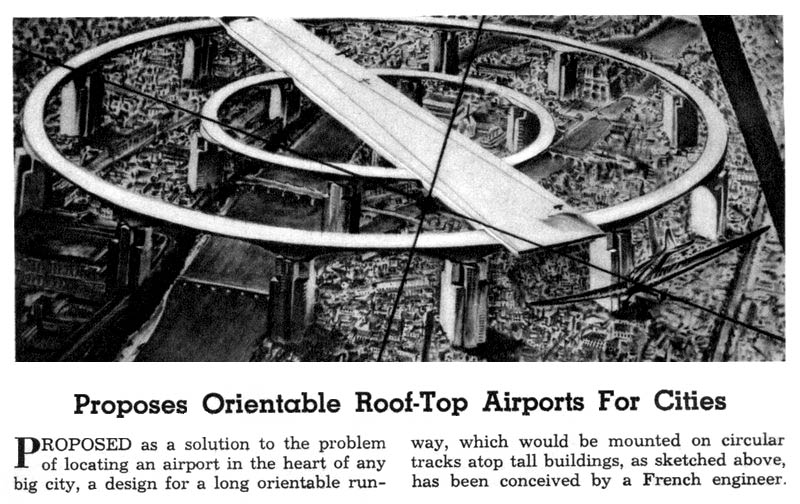 In an old (1938) issue of Modern Mechanix, we read how an unnamed "French engineer" once proposed, "as a solution to the problem of locating an airport in the heart of any big city, a design for a long orientable runway, which would be mounted on circular tracks atop tall buildings." This megalithic, concrete, aerospatial earth machine would "orient" itself along specific air routes, hurling planes aloft over the rooftops of the city.
In an old (1938) issue of Modern Mechanix, we read how an unnamed "French engineer" once proposed, "as a solution to the problem of locating an airport in the heart of any big city, a design for a long orientable runway, which would be mounted on circular tracks atop tall buildings." This megalithic, concrete, aerospatial earth machine would "orient" itself along specific air routes, hurling planes aloft over the rooftops of the city. Though Modern Mechanix tags the idea with both "aviation" and "impractical," clearly the editors have not read this fascinatingly absurd, and much less practical, conspiracy theory about Denver International Airport.
"What on earth is going on at Denver International Airport?" the website asks. "Or should we be asking what is going on UNDERGROUND there?" According to the conspiracist's own "guerrilla" reportage:
- • The Queen of England has reportedly been buying up property in Colorado under a proxy.
• There is a lot of "secret society" symbology at the airport, an AWFUL lot in fact
• The symbolism apparent in the layout of the new Denver airport, some feel, says that it may be a control center for world control
In any case, another (much more fascinating) article about urban airports of the future came out last month in Fast Company. There we read about the "rise of the aerotropolis":
- In the relatively obscure world of urban planning, [John] Kasarda, a professor at the University of North Carolina's Kenan-Flagler Business School, has made a name for himself over the past decade with his radical (some might say bone-chilling) vision of the future: Rather than banish airports to the edges of cities and then do our best to avoid them, he argues, we should move them to the center and build our cities around them.
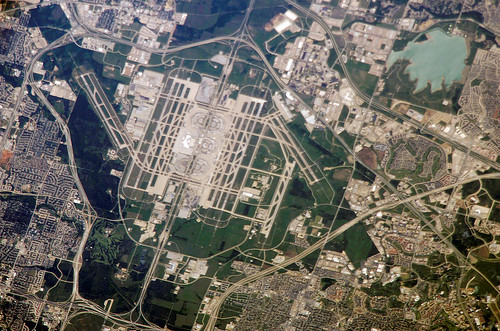 [Image: The neolithic geometry of Dallas-Fort Worth International Airport, a future archaeological complex which "occupies more surface area than the entire island of Manhattan." Image courtesy of NASA's Earth Observatory].
[Image: The neolithic geometry of Dallas-Fort Worth International Airport, a future archaeological complex which "occupies more surface area than the entire island of Manhattan." Image courtesy of NASA's Earth Observatory].Kasarda points out that an "invisible plexus of air-cargo networks" allows globalization to function. This is space as re-defined by corporate proximity, international accessibility, and cargo transport logistics:
- Over the past 30 years, Kasarda will tell you, global GDP has risen 154%, and the value of world trade has grown 355%. But the value of air cargo has climbed an astonishing 1,395%. Today, 40% of the total economic value of all goods produced in the world, barely comprising 1% of the total weight, is shipped by air (and that goes for more than 50% of total U.S. exports, which are valued at $554 billion). Raw materials and bulkier stuff still take the slow boats, but virtually everything we associate with our postindustrial, value-added economy – microelectronics, pharmaceuticals, medical devices, Louis Vuitton handbags, sushi-grade tuna – travels via jumbo jet. We may think of the 1960s as the jet-set era, but the supremacy of (soft) airpower has only now begun to reshape our ideas about how cities should look, how they should function.
Instead, we read, Hong Kong is now "premising its entire world-trade strategy on the primacy of the airport." Indeed, there is already "a mini-city stationed on a nearby island for [the airport's] 45,000 workers" – not to mention SkyCity, "a complex of office towers, convention centers, and hotels" for visiting CEOs and their consultant-class co-travelers.
In Beijing, "construction has begun on Beijing Capital Airport City, a $12 billion master-planned city of 400,000, and a massive airport expansion is coming to the city of Guangzhou, in the Pearl River Delta. Thirty-three miles to the south of Seoul, New Songdo City, billed as the most ambitious privately financed project in history, is taking shape in the Yellow Sea: The metropolis of 350,000 people, many of them expatriates living and working on-site for multinationals, is being built on a man-made peninsula the size of Boston."
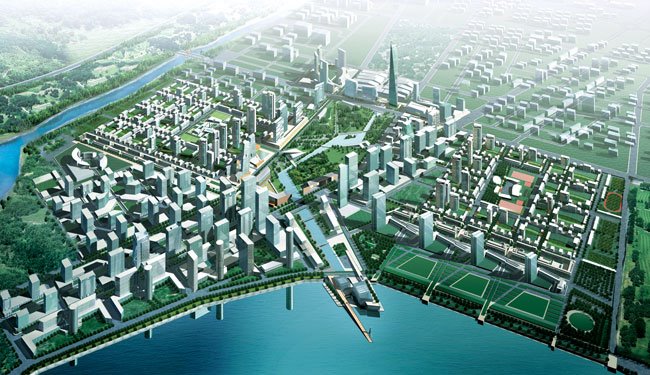
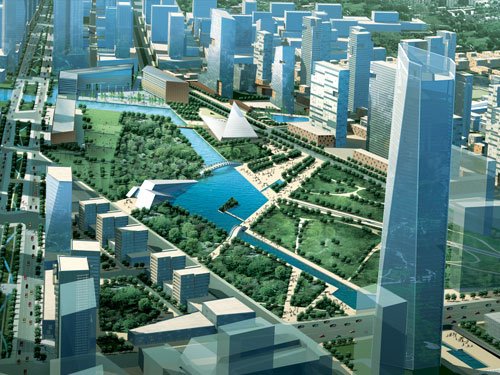
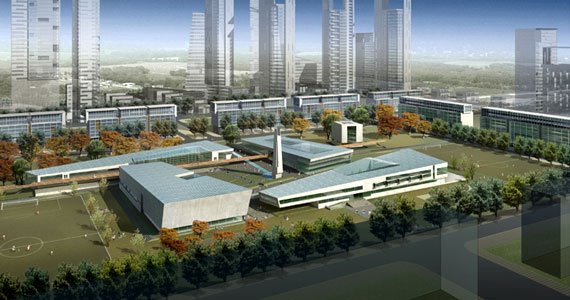 [Images: New Songdo City; courtesy Kohn Pederson Fox. New Songdo City was covered a long time ago on BLDGBLOG at the very end of this post].
[Images: New Songdo City; courtesy Kohn Pederson Fox. New Songdo City was covered a long time ago on BLDGBLOG at the very end of this post].Dubai, Frankfurt, Amsterdam, Suvarnabhumi – the latter an airport-city in Thailand "slated to become a self-contained province governed by the prime minister himself" – everywhere, we're led to believe, will soon turn in to an aerotropolis. It is the next phase of urban anthropological history.
This new land use model, after all, is where we will find the "hotels, merchandise marts, [and] convention centers," the "free-trade zones, factories, warehouses, and logistics hubs," the "giant clusters of apartment towers and bungalows," within which expat middle managers and their armies of business process consultants will both work and dwell. It is a heroic landscape through which the aero-globalized networks of world trade now pass – a new, post-urban "ecosystem" consisting entirey of "warehouses, trucking firms, factories, and offices," all "laboring in the shadow of the airport."
And if my phrase heroic landscape sounds hyperbolic, Fast Company refers to these aerotropoli as nothing less than "the regional outposts of titans."
Finally, the article returns to Kasarda:
- Despite a fondness for Olympian pronouncements, Kasarda is neither a Le Corbusier nor a Robert Moses (to name just two men who wanted to mold cityscapes in their own images). He sheepishly concedes that his visions of monstrous highways and multimodal cargo hubs would make Jane Jacobs – the late patron saint of human-scale cities – toss and turn in her grave.
What future Odyssey might be written in this archipelago of aerotropoli? From airport to airport, flying round the world, never seeming to leave one place... thus never arriving.
The Ulyssesian dilemma, or: self-exile in an age of aeromodernism.
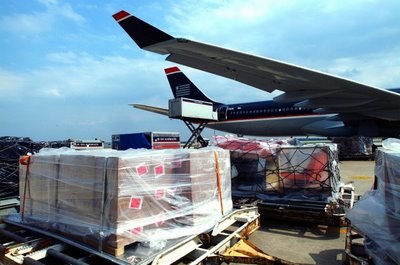 (Thanks to Divided Societies for pointing out the Modern Mechanix link; and to things magazine, where the aerotropolis article was originally spotted. More aero-dystopian links can be found at Brand Avenue, meanwhile, and one of John Kasarda's own papers on the rise of aerotropoli can be read here).
(Thanks to Divided Societies for pointing out the Modern Mechanix link; and to things magazine, where the aerotropolis article was originally spotted. More aero-dystopian links can be found at Brand Avenue, meanwhile, and one of John Kasarda's own papers on the rise of aerotropoli can be read here).





Comments are moderated.
If it's not spam, it will appear here shortly!
IMO, the interesting thing (in the Chinese-curse sense) about Kasarda is his insistence that aerotropoli must be completely branded spaces.
For what it's worth, I have some ill-tempered remarks on this. And on the rest of it.
Hello Geoff, i love your blog and recently i inserted a link to BLDG blog in my cool hunting blog!
Aeros Corp might put a twist to this story. Blimp technology has played on the edges of aviation for a while. Only recently have a few people put more modern technologies into blimp design and construction. I think there is room for a proto-type heavy lift blimp-plane that could result in cost savings, limited need for 'runway' and provide a much more sustainable model for airports as center of urban culture.
Speaking of Iain Sinclair and JG Ballard, I recently interviewed the former about the latter. The results have just gone up on Ballardian.com.
I guess it's a sign of the times, but looking at that first image of the rooftop airstrip, I can't help thinking how handy a design that would have been for terrorists trying to take out the city below.
This comment has been removed by a blog administrator.
By the way, I'm helping AIA Dallas promote its annual Ken Roberts Delineation Competition. For those who read this site, you may be interested in submitting an entry that displays talent in hand-rendering as well as computer rendering. One of the jurors will be Archinect's very own Chief Editor John Arbona. Click on the link below to find out more.
http://architectureandmorality.blogspot.com/2006/08/2006-ken-roberts-memorial-delineation.html
Some pretty visionary stuff. Stories about what lies beneath Denver International Airport have been part of local folklore for a while now, recalling how many Denverites were telling me about it when I lived there.
As for airports becoming the center of new urban agglomerations, I have yet to see that happening at one of the world's largest airports, DFW. Sure, driving through it kind of recalls some sort of city of future, with its Corbusian highway cutting through the middle feeding numerous ramps, topped by a brand new monorail system. Its ground plan does have a symmetrical symbolism about it, too. Still, beyond the airport grounds, very little urban density has resulted, with only the office complex of Las Colinas as the most visible urban result that directly followed the construction of DFW during the mid-Seventies. Otherwise it's mostly low-rise tilt-up structures and cookie-cutter homes that define the area around the airport
Hi Geoff,
At the 'Aeroworld' exhibition at the Stedelijk CS museum in Amsterdam, curated by Vitra (!), there was this design for a floating city in the middle of the ocean. It was designed at the time that an aircraft could not fly over the ocean in one flight, so the solution: build an airport in the middle of the ocean. This floating 'U'-form could also turn to the wind, like the design you mention here. Amazing stuff!
Unfortunately I cannot find a picture or details. The only thing near to an image is this:
http://sketchblog.ecal.ch/variable_environment/archives/2005/05/index.html
Ah ha!
Hong Kong already is a giant airport.
http://asiatime.blogspot.com/2006/04/my-little-airport.html
Love, alex
Post a Comment